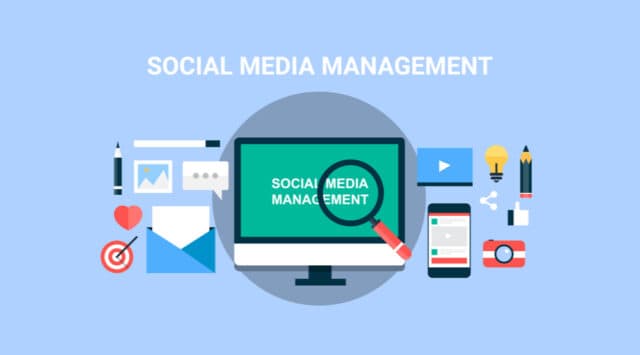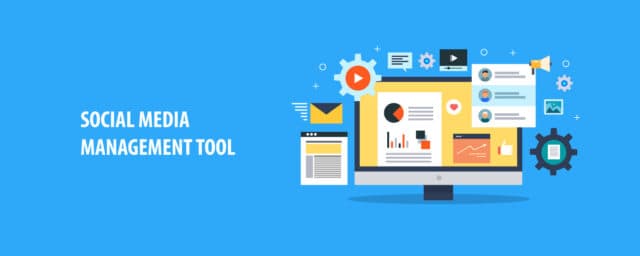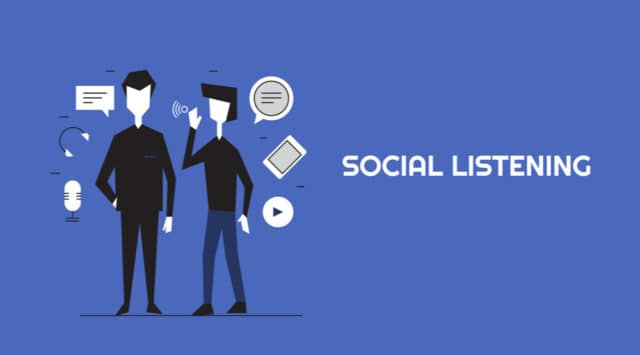Social Media Management & Communication: How Exciting is Social Listening?
As the person in charge of social media marketing and social media strategy, you must be able to identify new prospects and report on them. You also have to establish effective plans, monitor many social media accounts, and work under tight time constraints. As if all that weren’t enough, you have a growing social media team.

In order to build effective operations and produce outcomes, you’ll need solid management abilities. We know how stressful it can be. That’s why we’ve put up this step-by-step guideline on managing social networking sites. It covers everything from personal research, content development, scheduling posts, boosting engagement, social listening, and more.
What is social media management?
Social media management includes the analysis of social media audiences, developing a social media strategy, creating and sharing information for social accounts, monitoring online conversations, working with influencers, providing community services, tracking, gauging, and reporting on social network performance, and ROI.
These duties were once overlooked by organizations and have been brought to the forefront in marketing strategy. Why? You can generate revenue if you use social media properly.
What makes having a well-oiled social management system so crucial?

Social networks have enormous marketing potential. Social networking platforms can be used by brands to reach their marketing goals at every stage of the funnel, from brand recognition to increased shop visits.
Nevertheless, in order to reach these objectives, you’ll need to assemble a strong social networking team. Social media marketing will require more staff to achieve the goals you have. This will lead to complicated team structures on social media.
You may have multiple teams working in different areas and locations if you are a large company. This will enable you to attain a variety of objectives. How can you ensure that everyone is working together and getting the most out of social networking sites? The answer is to create a social media management process that works.
Where do I begin with social media strategy?
This concept is confusing for many marketers. To get off on the right foot, you must do three things:
- Examine your social media presence.
- Choose the right social media channel.
- Consider your intended audience.
We chose these three activities to highlight. They’ll give you valuable insights that will enable you to target your marketing reach. You’ll be able to concentrate your efforts on techniques that are effective while reducing the number of strategies that are ineffective. Let’s take a closer look at all of these responsibilities.
A social media audit is a fantastic concept
A social media audit may always help you enhance your social media management.
- This will provide you with a clear picture of your strategy’s effectiveness.
- As a result, you would be able to see where your resources are being used.
- It will reveal which social media platforms get the best results.
- It will display the impact of social media on search engine results.
How would you go about performing a social media health check?
- Step 1: Create a list of each of your organization’s social media accounts, including those from different locations and sub-brands.
- Step 2: Analyze key performance metrics like follower growth, user engagement (such as average engagement rates for specific months), publishing frequency, most excellent interactive content formats, top-performing custom post types, traffic sources, community attitude, inquiry response rate, turnaround time, audience preferences, demographic factors, and behavioral patterns using social media analytics.
- Step 3: Collect all the information and organize it into a tidy social media audit template.
- Step 4: Examine the data and identify areas that you can enhance. If you observe a drop in engagement, it could be due to poor quality content, ineffective targeting, or irregular publishing frequency.
This is the type of data you’ll really need to identify gaps in your strategy. After that, you may start the journey toward resolving issues and increasing the effectiveness of your social media monitoring activities.
Choose the suitable social media channels

Another crucial element of more effective social media management is selecting the right platform. It’s possible that after doing a social media audit, you’ll discover that some sites just don’t work for your company.
In that case, you should spend some time learning further about the work that will be needed to produce the desired outcomes.
A lot of it depends on who your intended audience is and where they live. If your research shows that your intended audience is mostly on Twitter, however, your visibility on the networking site isn’t great, you should definitely seek to enhance it.
You might want to try a new channel if your outcomes aren’t as excellent as you’d like and if your viewing public has moved on. However, before you do so, consider the following:
What are the company goals (raising brand recognition, generating leads, increasing website traffic, increasing conversions, etc.)? Will the platform allow me to achieve my business goals? How much revenue will I require to meet my goals?
- Will I be competent enough to accomplish well enough on the platform to create a profit? Will the sum be sufficient to cover the platform’s marketing costs?
- Are the demographics of the platform’s audience similar to the demographics of the people I’d want to reach?
- Is my target audience on the platform, and are they active? Will I be able to properly communicate with them?
- How well-known is the platform among marketers? How much material will I need to create to get noticed?
- Are there any of my direct competitors on the platform? What’s the matter with them? Is it feasible for me to perform better than they do?
Consider who you’re writing for
Evaluating your social media network is essential for effective social media management. Assessing your followers provides several benefits, including improved customer interactions, more quality information, and higher social media conversions. If you don’t undertake basic market research, on the other side, you risk going down a dangerous path and wasting funds and resources.
How can you get a thorough understanding of your social media audience?
Begin by segregating your audience into personas based on similarities, which you can accomplish with our free customer persona template. You may also let AI handle the work for you if you really want to make it easier for people. Your consumer personas are likely to be varied.
For example, you may have a group of teenagers enthusiastic about sports and a bunch of 30-year-olds who both like and engage with Digiday’s Facebook page. With this knowledge, you’ll be able to make good use of your resources by focusing on what works best for your community. Do you need help to determine who your social media primary audience is?
Ensure you’ve got the right social media management tools
To properly create, execute, and measure your social media marketing plan, you’ll need powerful social media management tools. What you’ll need is the following:
Tools for the top-to-middle-of-the-funnel
It’s incredibly vital to examine your top-to-mid-funnel audience. This is because the people in these phases, often known as the unseen audience, are your future consumers. You’ll be able to nurture these users toward conversion with targeted marketing efforts if you get to know them better.
So, what are the tools that will be useful at this point? Metrics for social media that are specific to the platform. You may acquire a lot of information about your audience through social media sites, including:
- Statistics about the Facebook audience: demographics, likes on the page, places, and activity.
- Instagram statistics: When your followers are the most active, top places, days, and occasions.
- Twitter statistics: Demography, style of living, customer behavior, and digital footprint are all factors to consider.
- Statistics using LinkedIn: Job description, experience, sector, organization size, and employment status are all factors to consider.
- Audience Research: These allow you to view your Facebook audience as demographic segmentation, hobbies, and behaviors. As a result, you’ll be able to save time that would have been spent manually performing audience research.
You’ll also be prepared to implement the findings of your audience research to use straight away.
Tools for the funnel’s bottom
Analyze the users at the bottom of the funnel, also known as a known audience, and utilize customer relationship management (CRM) technologies to focus on every aspect of the customer experience (CX).
This will give you a clear understanding of the consumers that bought the offerings, especially their demographics, interactions throughout their buyer journey, and the content that eventually persuaded them to buy.
Tools for content management

Content generation is a vital element of implementing a social media strategy, but it’s still one of the most difficult. Try these methods to make your content process more efficient and organized:
Idea generators for content
- Find out what’s going on the web and use it to your benefit by monitoring social media.
- Analyze what your rivals publish on social media and get motivated by some of their most exemplary and successful ideas.
- Analyze your audience to see what material they respond to positively.
- Content curation tools – use the internet to identify popular content that you may republish.
- Explore hundreds of great posts on social media for content ideas that will relate to each of your consumer personas.
Tools for creating content
- Visit these sources for free high-quality stock images: Unsplash, Pexels, and Pixabay.
- Create stunning graphics for your posts with Canva, Makeagif, and Awesome Screenshot.
- Create engaging social videos that your fans will want to share using Biteable, Lumen5, and Shakr.
- Work collaboratively with your team to develop social media copies using Google Docs, Grammarly, and Nuclino.
Editorial calendars for the social media platform
- Google Calendar – You can effortlessly schedule your articles using Google’s visual calendar.
- Google Spreadsheet – Make your own editorial schedule using a Google Spreadsheet customized for your requirements.
- Free calendar templates–use pre-made social media calendar templates to save time.
- Content calendar scheduler – Access a visual overview of your social media material, schedule and evaluate posts (even from mobile!), and have your team collaborate on any content-related activities from within the calendar with the content calendar scheduler.
Tools for posting on social media

Control social media publishing very effectively by posting to various sites with a single click using social media publishers. In addition, you’ll receive specific suggestions for the optimum posting times, allowing you to optimize your exposure and engagement.
Collaboration tools for influencers
Managing influencer connections is a relatively recent addition to the job area for social media managers. Nonetheless, it’s become one of their most critical to-do items. Here’s how you can manage influencer marketing initiatives effectively.
Explore the most relevant influencers for your fans and followers in moments with the AI-powered find influencers tool. Get a quick look at their demography, viewers, and interaction, as well as an easy-to-understand performance grade, so you can work with one of the most powerful influencers.
Tools for social customer service
Many consumers turn to social media to share their thoughts or ask inquiries about your company. You may require the following to manage all the incoming messages.
Community management – structure your interactions with your community with automatic alerts and clearly defined team roles and duties. View all of your incoming communications in one place and track your team’s productivity with filterable feeds so you can give excellent customer support.
What do you mean by social listening?
You’re overlooking some of the most crucial data available to help you boost your business if you might not have a social listening strategy in place. Indeed, approximately two-thirds of marketers feel that the value of social listening has risen in the past year.
By evaluating what consumers and potential customers say on social media platforms, social media listening technologies enable you to have a thorough picture of how they feel about you. You might also approach them and enquire about their opinions on the competition. This is fantastic market research that is available in real-time—if you know how to get it.
Social listening is the process of monitoring mentions as well as conversations about your business organization on social media sites and analyzing them for insights to identify opportunities to act.
It’s a two-part method:
- Step 1: Monitor social media for discussions about your brand, competitors, products, and business-related search terms.
- Step 2: Look over the data for ideas on what to place whatever you’ve learned. It might be as simple as reacting to a pleased consumer or as complex as changing your complete brand positioning.
Social listening vs. social monitoring

Although social listening might seem similar to monitoring social media, the concepts are very different. Social media monitoring is based on data collection. You can look back at previous events with metrics such as:
- Mentions of the brand
- Relevant hashtags
- Remarks from competitors
- Industry Trends
Social media monitoring can be used to track ROI and A/B testing campaigns. This data is also useful in demonstrating the significance of social media marketing when determining the annual budget. Statistics alone will not show the whole picture. It would be great if a post gets a lot of positive feedback.
If a post gets a lot of negative feedback or furious responses, it may not be so great. Social listening assesses the mood behind data as well as the numbers. This “virtual feeling” is sometimes referred to as “social media sentiment.”
The analysis of social media sentiment is an essential component of social media listening. It enables you to learn how customers perceive your business and your rivals.
Instead of monitoring how often your company is mentioned on social media, it’s important to examine what you can learn from these social dialogs to improve your bottom line.
You can quickly react to unexpected changes by being aware of social attitudes. Social surveillance, in essence, is a record of possible developments.
Social listening is distinguished by its ability to look forward and backward. It is all about understanding what you hear and how to apply it in your daily strategy and operations.
What’s the benefit of social listening strategies for your company?

If you don’t listen to social media, you are building your company plan blindly. Real people are active on the internet discussing your industry and brand. Learn what they are discussing for your long-term interest.
Social listening can help you gain insights that will benefit your customers. Here are a few methods by which social listening can support and impact your business.
Recognize your target market and engage with them
Social media can be used to better understand your customers and help you to deliver what they want. A customer, for instance, may tweet as to how much they enjoy your goods or services. You might also find a conversation in which people are looking for answers to questions that your product or service can answer.
Intelligence in the industry and its competitors
Social listening is not just about listening to what others are saying about you. Ask them about their opinion on your industry and competitors. This will give you valuable information about your position in the company.
You can see what your competing companies are doing instantaneously by using social listening. Is there anything new to offer? Are you developing promotional strategies? Maybe your conversations will uncover a market need you can meet. You can plan and react immediately to new opportunities and risks by strategizing and responding quickly.
Intelligence on Products
The monitoring of industry contacts can also provide a wealth of data on what works and what doesn’t for current and future customers. This data can be a goldmine for your customer service, product design, product creation, and marketing departments.
Are you able to improve or add a feature that addresses the issues being discussed? Perhaps your suggestions will encourage the creation of a new product. You will also find out about customer complaints about your products, as well as the complaints of your competitors.
Are there any solutions? You can make changes to solve the problem, but you need to use a targeted marketing strategy to tell them.
Preventing crises before they happen
You can monitor sentiment on a real-time basis by using social listening. This will allow you to see if people have been talking about you more frequently or if their emotion has changed.
This serves as an early warning system and alerts you to positive or negative changes in the perception of your brand online.
Find out why you are getting more engagement than normal. Your target audience has plenty to speak about what they like and dislike. These lessons can help you develop your multi-channel strategy.
Social listening can also help in the detection of public relations problems early. Social feedback can help you figure out what’s causing a drop in sentiment. If sentiment is low, you should make it a point to identify the cause and make changes immediately, such as removing problematic posts or apologizing for inappropriate tweets.
Complete your funnel
It is a great gesture to offer assistance and help people with their problems. Strangers online, however, hate it when businesses insert themselves into social chats with a harsh pitch.
Social listening is a great way to discover and participate in discussions about your industry via social media. These are all fantastic factors that encourage your business or voice your opinions. This must not be interpreted as an intention to sell right away.
Instead, view a social listening conversation as an opportunity to establish relationships with potential clients in your sector. These relationships can be nurtured into social selling partnerships.
Start a conversation, establish relationships, and give valuable information. This will better position your business as the best available resource for making purchasing decisions.
Find potential partnerships
You can monitor industry-related social media conversations to find the top opinion-makers and inventors in your field. These are individuals you need to get along with. These people may have an impact on your perception of yourself. It’s vital to know that this is a two-way street.
People who are experts in your field are more willing to aid you. Instead of trying to force yourself into a group that is already established, create partnerships with people who have an interest in the issues you are interested in.
Social listening can help you become a member of relevant online groups naturally and in a way that is considered beneficial, rather than being salesy.
People may be raving about your company on social media as well. These consumers are brand advocates. Reach out to these people and find ways to work together with your brand’s supporters.
Social listening tools

A social listening strategy will be much simple to execute with the help of social listening software. Here are a few top social listening tools.
Hootsuite
To track keywords, mentions, and tags, you can set up social media streams within Hootsuite. Instead of having to log in and out of multiple social media sites, you can view and respond to any mentions or discussions from one dashboard.
Hootsuite helps you monitor the competition and make connections with social network creators (a.k.a. Influencers and potential brand evangelists).
Synthesio
Synthesio monitors conversations in very specific groups. You can also split your social listening data according to language, geography, demographics, and gender. The reports also include a useful social reputation score.
Talkwalker
Talkwalker’s social listening tools monitor all social media sites, including blogs, videos, discussion boards, and forums.
They have data access from more than 150 million sources. You will be able to monitor and evaluate brand-related interactions such as exposure, interaction, remarks, and sentiment.
Netbase
Natural Language Processing (NLP) is used by NetBase to assist you to concentrate your social listening on the most important discussions. It accumulates data from millions of social posts every day, as well as over 100 billion archive posts from networking sites.
Adview
Adview can only be used for Instagram and Facebook ads for social listening. You can track up to 3 Facebook Ad Accounts on an unlimited number of pages.
Crimson Hexagon’s ForSight
You can filter your social listening streams with ForSight’s emotion and opinion categories, gender, region, influence score, and gender filters. You can connect with large audiences in real-time thanks to accessing over 400 million social media posts.
Mentionlytics
Mentionlytics searches for mentions, hashtags, and sentiments on social media networks and news sites. It can also search blogs and news websites for mentions and sentiments in multiple languages. Influencers can be found using social media as well as other digital resources.
Digimind
Digimind collects data from around 850 million studies in over two hundred languages. Digimind analyzes mentions and uses artificial intelligence to track sentiment and trends. It then presents data visualizations that are useful.
Subscribe to our Newsletter
Sign up to receive email updates on new product announcements, exclusive sales and marketing content, special offers on email validation plans, and more.
We send curated content as per your preference and do not indulge in spam!
What would you like to know about
We’re committed to your privacy. TuxMailer uses the information you provide to us to contact you about our relevant content, products, and services. You may unsubscribe from these communications at any time. For more information, check out our privacy policy.



